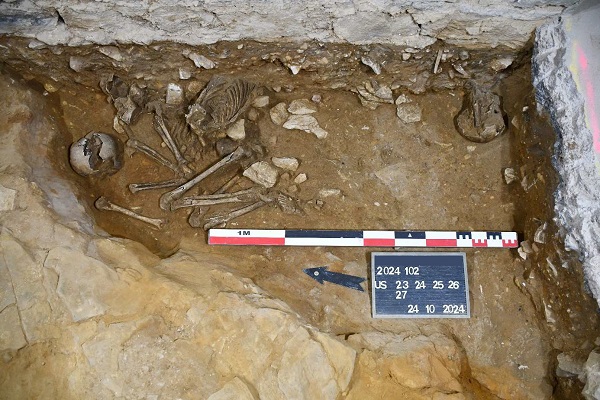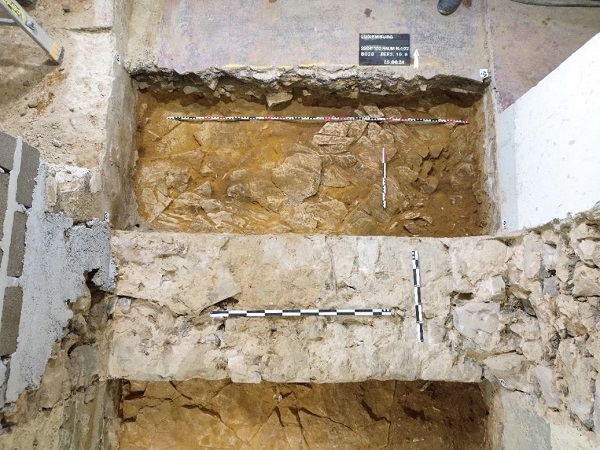 Mass grave discovered in Luxembourg City;
Credit: Cinzia Pizzagalli (Archeo Diag)
Mass grave discovered in Luxembourg City;
Credit: Cinzia Pizzagalli (Archeo Diag)
Chronicle.lu has teamed up with Luxembourg's National Institute for Archaeological Research (Institut national de recherches archéologiques - INRA) for a series of articles on archaeological digs and discoveries around the Grand Duchy.
The series explores digs spanning from prehistoric to Roman and medieval times, highlighting key finds and what they reveal about Luxembourg’s past. It also sheds light on the work of the INRA and its approach to archaeological and historical research.
The latest article in this series looks at the discovery of a mass grave in Luxembourg City.
Archaeological work is regularly carried out in Luxembourg City as part of redevelopment projects. Construction work taking place inside older buildings is subject to archaeological supervision (“suivi archéologique”). This involves monitoring the removal of floors and walls and documenting any findings of historical significance. However, archaeologists also carry out small test trenches at selected locations to obtain a more accurate picture at an early stage.
In this specific case, extensive renovation work was being carried out inside a building that was constructed in the 1890s. The house had been built after the destruction of the Luxembourg Fortress in an area where the second city wall (built between 1325 and 1340) had stood. As the construction work was also to be carried out in the basement, it was clear that construction supervision would be necessary, with the main aim of locating the city wall.
Most of the finds from the test trenches date from the building's construction and occupation or use, i.e. from the 19th and 20th centuries. Human bones were discovered several times during the work, but these came from layers of rubble and could not be placed in a historical context. This changed when archaeologists came across a pit that had been dug into the sandstone rock. The upper layers were covered with rubble, but after a few centimetres, the picture changed: the finds were now older and the first human bones appeared, this time in context. As the archaeologists continued to excavate, it became clear that several people had been buried here in a mass grave. Once it was clear that this was a mass grave, colleagues specialising in human remains took over the excavation and documentation work.
These specialists worked their way down into the narrow pit and counted twelve dead bodies. The orientation of the bodies inside the pit appears to be random, with the positions of the bodies varying between supine and lateral. Some of the dead are also lying twisted in the pit. It is likely that the dead were buried quickly.
Among the twelve burials documented during the excavations, there are four adults and eight children or adolescents. The adults appear to have been women. Gender determination based on bone characteristics is not reliable in children and adolescents. All the deceased had at least one tooth with caries, and other stress markers and signs of disease were also found. Anthropologists suspect that some of the dead may have been people of colour due to different markers on the skull bones. As this methodology is controversial among experts, two bone samples have been sent to a specialist laboratory for DNA analysis. The results are still pending.
It appears that lime was sprinkled over some of the bodies; traces were found in the soil and in varying discolouration of the bones. However, lime is not documented on corpses from the early Middle Ages and was not very common in the high and late Middle Ages. Based on the available sources, it seems to have become widespread only during the 17th century. The purpose is to reduce the odour of decomposing corpses.
No traces of clothing, shoes or other grave goods were found. Only a piece of pottery (dating from around the 15th/16th century), a tooth and a rusted iron object that could not be identified were discovered in the pit. This makes it difficult to date the pit; the only thing that is certain is that it dates from between the 15th century (due to the shard) and 1890 (when the house was built). To find out more, a sample will be dated using the radiocarbon method.

Credit: Daniele Marincola (DokuPlus)








